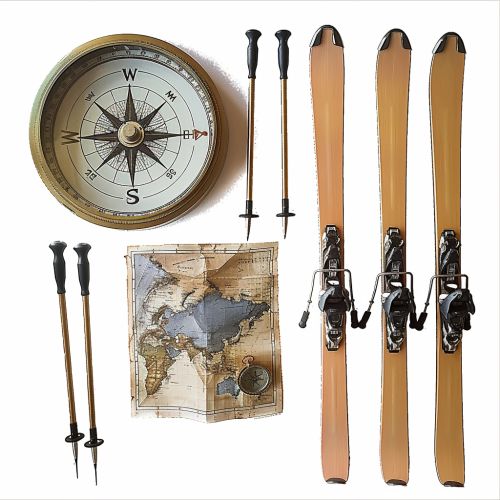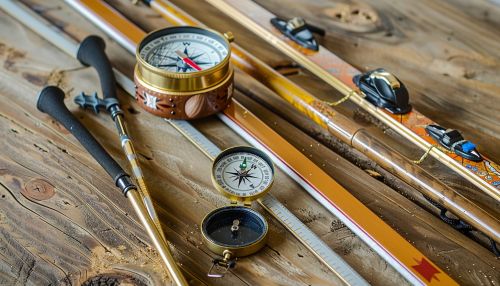Ski Orienteering: Difference between revisions
No edit summary |
No edit summary |
||
| Line 8: | Line 8: | ||
Ski orienteering equipment includes cross-country skis, poles, a compass, and a map holder. The map holder, which is attached to the athlete's chest, allows the map to be easily read while skiing. The maps used in ski orienteering are topographic, showing contour lines, vegetation, and other features of the terrain. They are specially designed for the sport, with symbols indicating the navigability of the terrain on skis. The maps are usually at a scale of 1:10,000 or 1:15,000. | Ski orienteering equipment includes cross-country skis, poles, a compass, and a map holder. The map holder, which is attached to the athlete's chest, allows the map to be easily read while skiing. The maps used in ski orienteering are topographic, showing contour lines, vegetation, and other features of the terrain. They are specially designed for the sport, with symbols indicating the navigability of the terrain on skis. The maps are usually at a scale of 1:10,000 or 1:15,000. | ||
[[Image:Detail-77933.jpg|thumb|center|A set of cross-country skis, poles, a compass, and a map holder.]] | [[Image:Detail-77933.jpg|thumb|center|A set of cross-country skis, poles, a compass, and a map holder.|class=only_on_mobile]] | ||
[[Image:Detail-77934.jpg|thumb|center|A set of cross-country skis, poles, a compass, and a map holder.|class=only_on_desktop]] | |||
== Rules and Techniques == | == Rules and Techniques == | ||
Latest revision as of 12:59, 8 May 2024
Introduction
Ski orienteering (SkiO) is a competitive winter sport that combines cross-country skiing and orienteering. Participants navigate a network of control points in diverse and challenging winter terrains using a map and compass. The sport requires both physical endurance and navigational skills, with athletes choosing their own routes to reach the control points in the shortest time possible. Cross-country skiing techniques and equipment are used, along with special maps designed specifically for ski orienteering. The sport is governed by the International Orienteering Federation (IOF).
History
The origins of ski orienteering can be traced back to Scandinavia, where skiing and land navigation have been essential survival skills for centuries. The sport evolved from military training exercises in the late 19th and early 20th centuries. The first recorded ski orienteering competition took place in Norway in 1897. The sport gained popularity in the 1960s and 1970s, and the International Orienteering Federation (IOF) began sanctioning international ski orienteering events in 1975. The first World Ski Orienteering Championships were held in Finland in 1977.
Equipment
Ski orienteering equipment includes cross-country skis, poles, a compass, and a map holder. The map holder, which is attached to the athlete's chest, allows the map to be easily read while skiing. The maps used in ski orienteering are topographic, showing contour lines, vegetation, and other features of the terrain. They are specially designed for the sport, with symbols indicating the navigability of the terrain on skis. The maps are usually at a scale of 1:10,000 or 1:15,000.


Rules and Techniques
In ski orienteering, athletes must visit a series of control points in a specific order. The control points are marked on the map and in the terrain by orange and white flags. The route between the control points is not specified and must be chosen by the athlete. The athlete with the fastest time wins.
Ski orienteering techniques include both skiing techniques and orienteering techniques. The skiing techniques are similar to those used in cross-country skiing, with both classic and skate skiing styles allowed. The orienteering techniques involve map reading, route choice, and navigation while moving at high speed.
Competitions
Ski orienteering competitions are held at local, national, and international levels. The most prestigious international competition is the World Ski Orienteering Championships, held every two years. Other major competitions include the European Ski Orienteering Championships and the Junior World Ski Orienteering Championships.
Competitions are held in several formats, including sprint, middle distance, long distance, and relay. In the sprint format, the course is shorter and the navigation is simpler, with a focus on high speed. In the middle and long distance formats, the courses are longer and the navigation is more complex. The relay format involves teams of three or four athletes, with each athlete skiing a leg of the course.
Training
Training for ski orienteering involves both physical training and technical training. The physical training is similar to that for cross-country skiing, with a focus on endurance, strength, and speed. The technical training involves practicing map reading and navigation skills, both on skis and on foot. Athletes also train to make quick decisions about route choice while moving at high speed.
